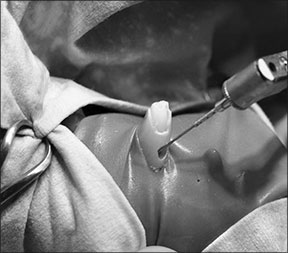Root canal treatment for cats might sound far-fetched, but they’re performed at university hospitals and specialty practices around the country to save damaged and diseased teeth that might otherwise be extracted. In fact, newly available techniques and equipment in veterinary medicine have advanced the field of endodontics — the study and treatment of dental pulp — to the point where root canal treatment success rates in pets equal those in humans.

288
In the past three years, Santiago Peralta, DVM, chief of the Section of Dental and Oral Surgery at the Cornell University College of Veterinary Medicine, has helped move the animal hospital’s use of hand instruments for root canal treatments to more precise rotary instruments.
Safer Procedure. The result: The advanced techniques provide better results and more favorable outcomes. Because rotary files are much more efficient, the length of a procedure under general anesthesia is reduced significantly, making the procedure safer.
“Rotary endodontic files are attached to an electric handpiece that allows precise control of speed and torque, which reduces the chances of complications during a root canal treatment,” says Dr. Peralta, who is board-certified in veterinary dentistry. “Also, the files are made of a nickel-titanium alloy, making them incredibly flexible and more resistant to breakage and other complications compared to conventional stainless steel hand files.”
Nickel-titanium rotary endodontic instruments were first developed for use in humans more than two decades ago, but specially designed instruments for small animals started to become popular in veterinary medicine only in the past decade, Dr. Peralta says.
Today, rotary endodontics are widely available in both private practice and academic veterinary medicine. “However, because endodontics require advanced training and skills, and a large number of costly equipment and materials, root canal treatments are usually not available through general practitioners, only through board-certified specialists,” Dr. Peralta says.
The most common reason for a root canal treatment in cats is dental trauma, Dr. Peralta says. “Fractured or discolored teeth are frequently devitalized and lead to chronic low-grade pain, and sometimes acute swelling and/or drainage. The treatment options are generally a root canal treatment or extraction. Even though extraction is a valid definitive solution to a non-vital tooth, a root canal treatment offers the advantage of preserving the tooth and is a less invasive treatment option.”
In human medicine, root canal treatments can be performed on any damaged or diseased tooth in the mouth. In cats, because of the small size of their teeth, root canal treatments can be performed only on canine teeth — the long, fang-like teeth at the front of the mouth, Dr. Peralta says.

288
Veterinary dentists perform root canal procedures when the pulp inside the tooth becomes damaged or the nerve of the tooth becomes infected. They remove the nerve and pulp, then clean and seal the tooth. The goal is to preserve the tooth’s function without the pulp and nerve.
When a cat fractures his canine tooth, often only the tip of the tooth is damaged. Unfortunately, the pulp of the tooth extends to the tip of the canine tooth and is likely to be affected by even a minor crack or chip.
Masking Pain. Anyone who has ever experienced a toothache, particularly one that necessitated a root canal treatment, knows it can be extremely painful, but cats tend to hide their pain and rarely show obvious signs of discomfort. Many owners remain unaware of their cats’ dental problems or dismiss other signs of problems because their pets don’t seem overly bothered. However, ignoring the problem prolongs the cat’s pain and can lead to more serious complications (see sidebar on the facing page).
Spotting a damaged or infected tooth requires owner vigilance. In rare cases, a fractured or infected tooth might be associated with swelling in the cat’s mouth and face, or fluid draining below the eye. Antibiotics
might temporarily resolve these symptoms, but if the problem is related to a damaged tooth, it will recur.
More often, owners must look for more subtle signs and behavioral changes. A cat might avoid chewing on one side of his mouth or hesitate to chew on formerly beloved toys.
Beyond observing behavior, owners should regularly inspect their cats’ teeth by lifting the lip with the mouth closed. Any fractures or discolorations should be brought to the attention of a veterinarian.
If a tooth fracture is observed or an infection is suspected, dental X-rays are the first step in diagnosis. The images help the veterinarian evaluate the bone surrounding the tooth and confirm whether the pulp or nerve of the tooth has been affected.
Based on the findings, the veterinarian can determine whether tooth extraction or root canal therapy is the better option. Although preserving the tooth is desirable, in some situations an extraction might be recommended over a root canal treatment, particularly if damage to the tooth is extensive.
Cats of any age and breed can be affected by tooth fractures that warrant a root canal treatment or extraction. Younger pets, however, might have additional treatments available to them, such as vital pulp therapy, if fractures are recent.
A discussion with your cat’s veterinarian about all available options is the best course.
Significant Cost: Fees start at around $1,000 to $1,200 and varies depending on the tooth or teeth that require treatment, Dr. Peralta says. “This cost usually includes pre-anesthetic bloodwork, general anesthesia, dental X-rays and the procedure.” In humans, root canal treatments can be performed without general anesthesia. Understandably, pets require complete immobilization for a delicate procedure to be performed inside the mouth.
Although tooth trauma and disease in cats aren’t entirely preventable, owners can reduce the risk. Tooth fractures in cats are commonly the result of trauma such as being hit by a car, falling from a height or being attacked by another animal. Although cat owners can take steps to reduce the risk, tooth fractures clearly aren’t entirely preventable. Regardless of preventive measures, dental trauma can still occur. Fortunately, veterinary dentistry has made progress in only a decade, and prompt attention to problem teeth can alleviate pain and greatly enhance a cat’s quality of life. ❖


